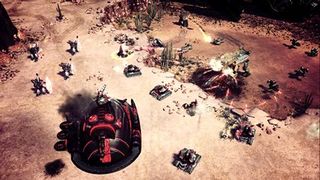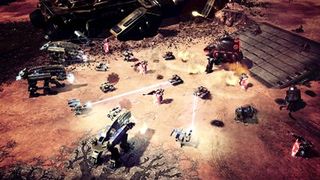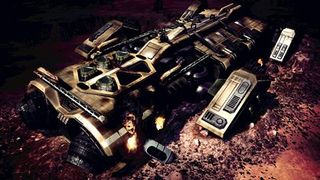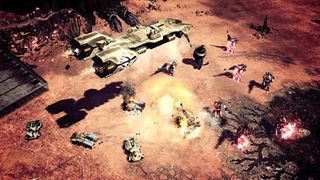See, we always knew that bald guy known only as Kane was a decent fellow. He was just misunderstood, only wanting a better world for the entire human race. Granted, he may be responsible for the deaths of thousands and his insane quest for personal deification and radioactive tiberium crystals is the reason the world has turned into a bleak, green, irradiated wasteland. But forgive and forget? Everyone makes mistakes, after all.

Now Kane’s trying to make amends, which is why he’s approaching the GDI (Global Defence Initiative – C&C’s goodies) with a plan, one that might just save the putrid galactic scab one might call Earth. His plan is simple – an alliance. The GDI and Kane’s Brotherhood of Nod (the baddies) working together to push back the tiberium menace and help get the planet back on its feet.
Introduced in one of those gloriously campy (and now superbly hi-res) movies that the Command & Conquer series is renowned for, Kane holds some strange orb in his hand while he makes the proposition. The GDI guys look a bit nervous, but we know they decide to agree, perhaps after some tough negotiation or maybe just after a curry and a night out on the tiberium cocktails. While we don’t know yet who will actually make an appearance (we know for sure Ric Flair won’t be in it, sadly) the cast are sure to bring life to the story, as they’ve always done.

This meeting takes place 10 years after the events of the previous game. Fast forward another 15 and you’ve got the present day in C&C4 terms. The plan is coming to fruition, the Tiberium Control Network is almost complete and the two factions have been skipping merrily together in tiberium-free fields for a decade and a half. A new golden age for humanity is said to be dawning. So, of course, as is the way of things in game land, things go terribly, terribly wrong. We don’t know how they go wrong, nor would we tell you if we did, because it would spoil the story. But it does and the GDI and Nod are back at each others’ throats once again, the fate of mankind in the balance once more.
One of the things Jim Vessella, producer on the C&C4 project, was eager to stress was the notion of appealing to both hardcore and new users. A common enough refrain, of course, and one that is hardly easy to attain. To be fair to him, it does seem like the game could be significantly different to its predecessors, although not in a “shit, they’ve ruined it!” kind of way. There’s definitely more of a “hmm, that sounds interesting” vibe to the project at the moment. How much you agree with that statement depends on the following passages, so let’s get cracking.
Essentially C&C4 is the same game as all the others. You build a base with a mobile MCV (called a Crawler in this one – well, ish... we’ll get back to this a little later) and set about churning out a big army of tanks, infantry, engineers and other instruments of mechanised destruction. You can do this as either the GDI or the Brotherhood of Nod, each with their own distinct units.

The first place C&C4 differs from its ancestors is that you have to choose a class, which basically means choosing between Offence, Defence and Support unit load-outs. Each one has its own specific roster with unique roles to play. For example, using Defence gives you heavy turrets to deploy, but very little in the way of quick, incisive attack troops with which to gain ground; offence does the opposite; and Support gives you the option to properly utilise aircraft, artillery and transports. You must pick one of these before starting a game, so it’ll be important to think about what you plan to do or what your preferred style is.
This is absolutely essential to what EA Los Angeles are planning for C&C4, specifically when you consider that you can’t actually be defeated. This doesn’t mean that your units are invincible – far from it – but if your Crawler (or the equivalent depending on which class you’ve chosen – the Crawler is used for the GDI’s Offence class) is destroyed, it isn’t the end of the world. You’ll then get the chance to respawn as either the same class or a different one. How well this idea will work can only be divined from a proper play test, of course, but it has the potential to make irritating build-and-rush tactics less of a pain in the backside.

While we’re still sure that quick-fingered and quick-rushing gameplay will be essential to mastering the game, Vessella stresses the effort the development team are putting in to shift the balance of power towards a middle ground, where people who don’t even know what a hotkey is could have a chance of putting up a good fight.
The respawns, which could be unlimited or regulated by the chosen difficulty level, will also go some way to helping players alleviate the frustration of sudden rush deaths. Vessella believes that C&C4 will be more layered strategically than previous games in the series, with longer missions than in Red Alert 3 and more changing up of tactics because of the extra mobility provided by the Offence and Support classes.
Finally, we come to probably the biggest change to the C&C formula – persistent XP. Killing units, destroying structures and completing objectives all earn you experience, which allows you to unlock new units to use later on in the campaign. However, this can also be earned in the skirmish and multiplayer modes. We think this could be rife for abuse -players perhaps setting up easy win games in the skirmish mode and just grinding experience. Vessella recognises this, but doesn’t believe it’ll be a problem. In fact, it will be a definite bonus for inexperienced players who can “buff” themselves with practice in the other modes, bringing better units to the difficult campaign mission they previously failed to crack.

One thing we’re aware of that leaves a sour taste is that C&C4 needs a constant internet connection. EA say it’s down to players’ progress needing to be tracked at all times. So it’s not DRM… sort of. It seems to us that C&C4 could be the game that brings back players bored of the same old mechanic used since, effectively, 1995. While not reinventing the wheel, EA Los Angeles have definitely gone beyond the minute token changes we so often associate with big name releases from established franchises.
Whether these alterations work or not is a matter for you yourself, depending on your love/loathing of the base-building RTS mechanic, but what we’re certain of is that, for the first time since the late ’90s, we're really looking forward to playing Command & Conquer. That’s definitely saying something.
